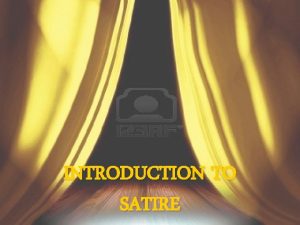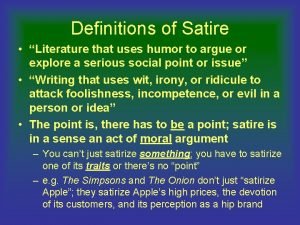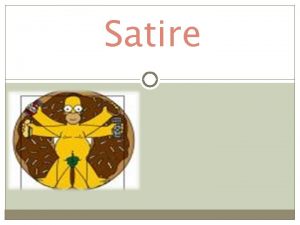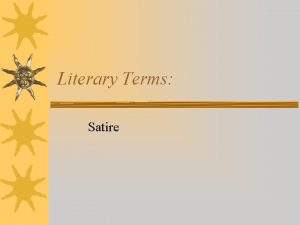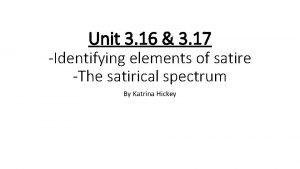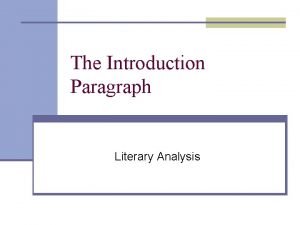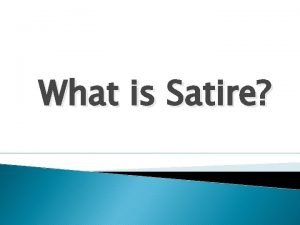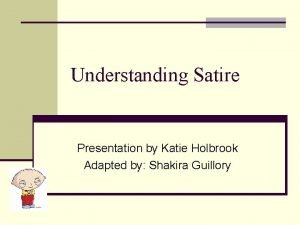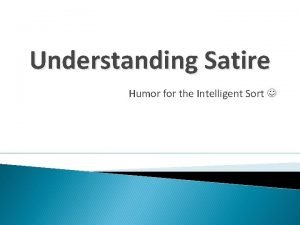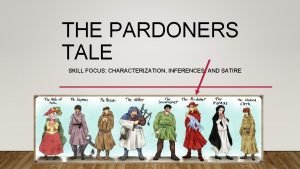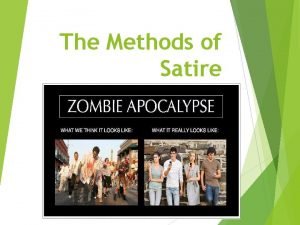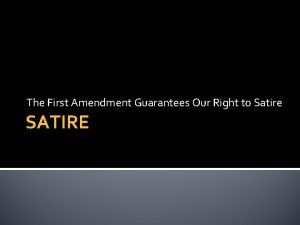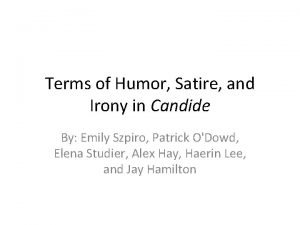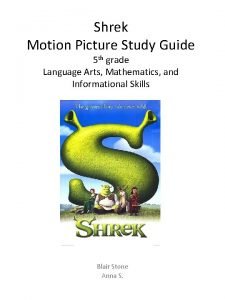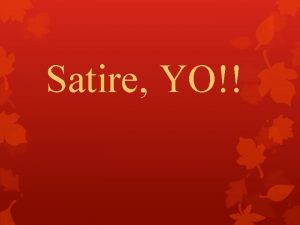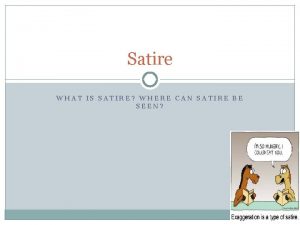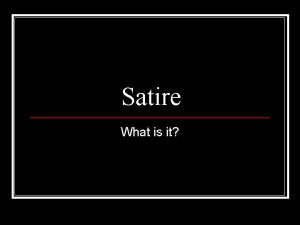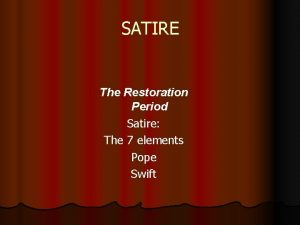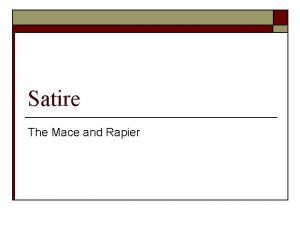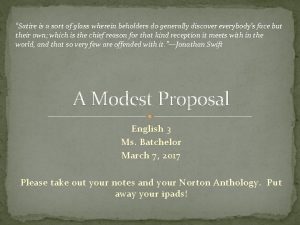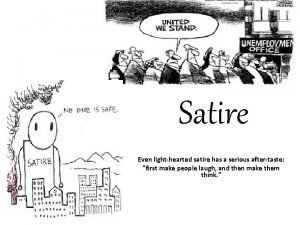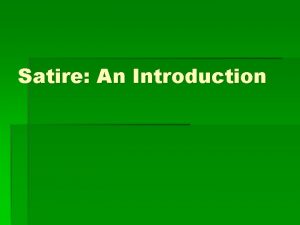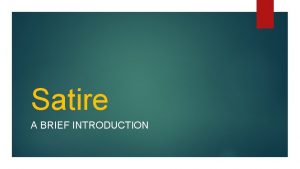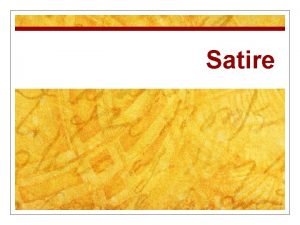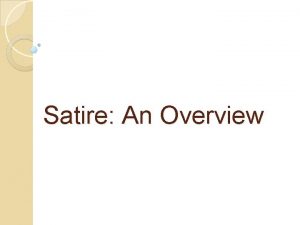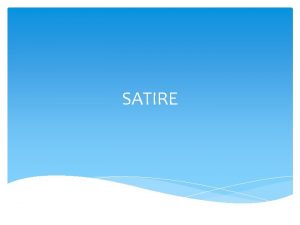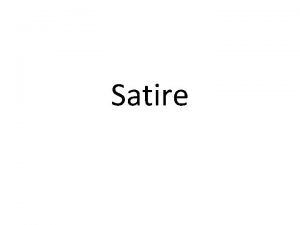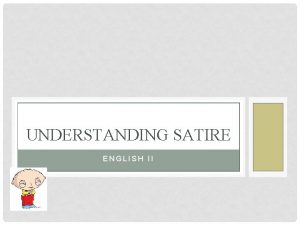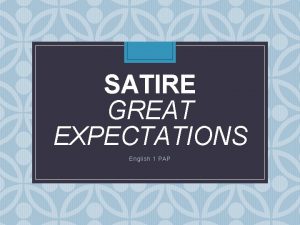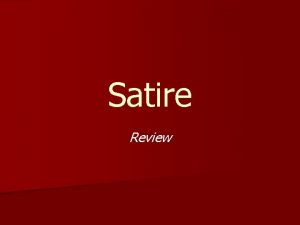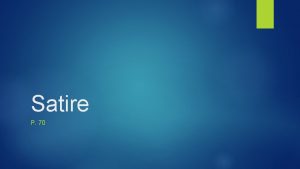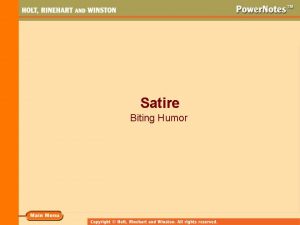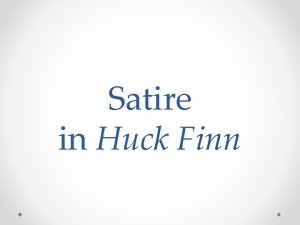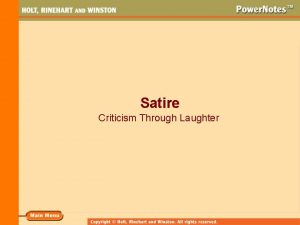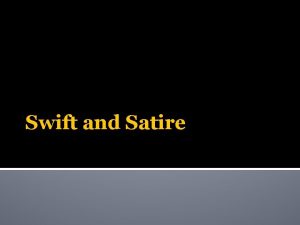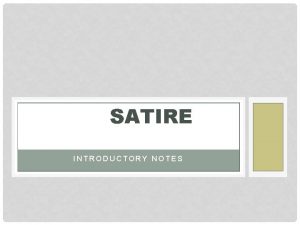Introduction to Satire Satire Satire is a literary





























- Slides: 29

Introduction to Satire

Satire ¦Satire is a literary genre that uses irony, wit, and sometimes sarcasm to expose humanity’s vices and foibles, giving impetus, or momentum, to change or reform through ridicule. ¦It is a manner of writing that mixes a critical attitude with wit and humor in an effort to improve mankind and human institutions.

Satire ¦While some writers and commentators use a serious tone to persuade their audiences to accept their perspective on various issues, some writers specifically use humor to convey a serious message.

Satire

Types of Direct Satire ¦Horatian satire is a type of direct satire which pokes fun at human foibles with a witty even indulgent tone. ¦Juvenalian satire is a type of direct satire which denounces, sometimes with invective, human vice and error in dignified and solemn tones.

Horatian Satire ¦ This type of satire is named after the Roman satirist Horatian. ¦ It seeks to criticize, rather than attack, immorality or stupidity. ¦ In general, Horatian satire is gentler, more sympathetic, and more tolerant of human folly. ¦ Unlike Juvenalian satire, it serves to make us laugh at human folly as opposed to holding our failures up for needling. ¦ Horatian persons. ¦ It satire tends to ridicule human folly in general or by type rather than attack specific tends to produce a smile.

Horatian Satire

Juvenalian Satire ¦This type of satire is named after the Roman satirist Juvenal. ¦It is harsher than Horatian satire because it often attacks and shows contempt for people. ¦Often, it seeks to address some evil in society through scorn and ridicule. ¦The Juvenalian satirist approaches his work in a more serious manner and uses dignified language to attack erroneous thinking or vice. ¦In this way Juvenalian satire evokes feelings of scorn, shock, and righteous indignation in the mind of the reader.

Juvenalian Satire

Characteristics of Satiric Writing ¦Irony ¦Hyperbole ¦Understatement ¦Caricature ¦Wit ¦Sarcasm ¦Ridicule ¦Parody ¦Invective ¦Incongruity (litotes)

Irony ¦Irony is a mode of expression, through words (verbal irony) or events (irony of situation), conveying a reality different from and usually opposite to appearance or expectation. ¦The surprise recognition by the audience often produces a comic effect, making irony often funny.

Irony ¦When a text intended to be ironic is not seen as such, the effect can be disastrous. ¦To be an effective piece of sustained irony, there must be some sort of audience tip-off, through style, tone, use of clear exaggeration, or other device.

Irony

Hyperbole ¦Hyperbole is deliberate exaggeration to achieve an effect; overstatement.

Litotes ¦Litotes are a form of understatement that involves making an affirmative point by denying its opposite. ¦ For Example: ¦ “Being tortured with fire must have been somewhat uncomfortable. ” ¦ “Rap videos with dancers in them are not uncommon. “ ¦ “There a few Starbucks in America. "

Caricature ¦A caricature is an exaggeration or other distortion of an individual's prominent features or characteristics to the point of making that individual appear ridiculous. ¦The term is applied more often to graphic representations than to literary ones.

Caricature

Wit ¦Wit is most commonly understood as clever expression, whether aggressive or harmless; that is, with or without derogatory intent toward someone or something in particular. ¦We also tend to think of wit as being characterized by a mocking or paradoxical quality, evoking laughter through apt phrasing.

Wit

Sarcasm ¦Sarcasm is intentional derision, generally directed at another person and intended to hurt. ¦The term comes from a Greek word meaning “to tear flesh like dogs” and signifies a cutting remark. ¦Sarcasm usually involves obvious, verbal irony, achieving its effect by jeeringly stating the opposite of what is meant so as to heighten the insult.

Sarcasm

Ridicule ¦Ridicule is the use of words intended to belittle a person or idea and arouse contemptuous laughter. ¦The goal is to condemn or criticize by making the thing, idea, or person seem laughable and ridiculous.

Ridicule

Parody ¦A parody is an imitation of an author or his/her work with the idea of ridiculing the author, his/her ideas, or the work itself. ¦A parodist exploits the peculiarities of an author’s expression—the propensity to use too many parentheses, certain favorite words, or other elements of the author’s style.

Parody ¦“Amish Paradise” Weird Al Yankovic

Invective ¦Invective is speech or writing that abuses, denounces, or attacks. It can be directed against a person, cause, idea, or system. ¦It employs a heavy use of negative emotive language. ¦For Example: “I cannot but conclude the bulk of your natives to be the most pernicious race of little odious vermin that nature ever suffered to crawl upon the surface of the earth. ” (Swift, Gulliver’s Travels)

Incongruity To present things that are out of place or are absurd in relation to its surroundings.

Bellringer ¦Watch the following video: ¦http: //youtu. be/OSXNU 1_bouc ¦As you watch, jot down all of the various characteristics of satire you see in the video. ¦Then, determine whether the video is Horatian or Juvenalian satire and write a sentence or two explaining why.

Apply It! ¦ Read “Let’s Hear it for the Cheerleaders, ” the satiric piece on pages 169 -71 in your Spring. Board books. ¦ As you read, mark the text for areas you find funny. ¦ Then, fill out the charts on pages 173 -172, quoting passages you found funny, explaining why you thought each was funny, and interpreting what each quote is saying. ¦ Determine which terms from our lesson best fit the examples of humor you identified on your chart. ¦ Finally, respond to the following prompt in a five sentence minimum paragraph: ¦ How does David Bouchier’s article fit the definition of satire? Support your answer with specific evidence from the text.
 Invective satire
Invective satire Satire definition literature
Satire definition literature Is satire a literary device
Is satire a literary device Literary terms satire
Literary terms satire Satire examples literature
Satire examples literature Invective satire
Invective satire Literary devices definition
Literary devices definition Introduction to poetry literary devices
Introduction to poetry literary devices Literary analysis introduction
Literary analysis introduction Intro paragraph layout
Intro paragraph layout Technique of satire
Technique of satire Satirical techniques
Satirical techniques The three golden questions of satire are:
The three golden questions of satire are: Mr collins satire
Mr collins satire The pardoner's tale character analysis
The pardoner's tale character analysis Analyze this picture
Analyze this picture Great gatsby historical context
Great gatsby historical context Satire advertisement
Satire advertisement Socratic irony
Socratic irony Shrek satire worksheet
Shrek satire worksheet Henry ford family guy
Henry ford family guy What is satire
What is satire Satire
Satire What is satire
What is satire Restoration satire
Restoration satire Satire techniques
Satire techniques Satire is a sort of glass meaning
Satire is a sort of glass meaning Humor in huck finn
Humor in huck finn Princess fiona fights robin hood
Princess fiona fights robin hood Light hearted satire
Light hearted satire
